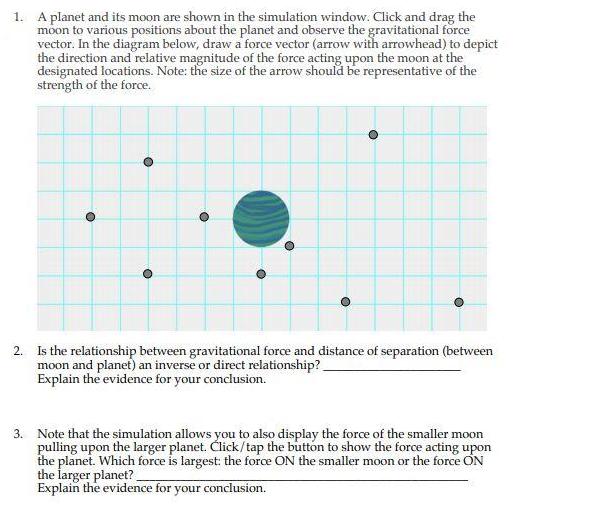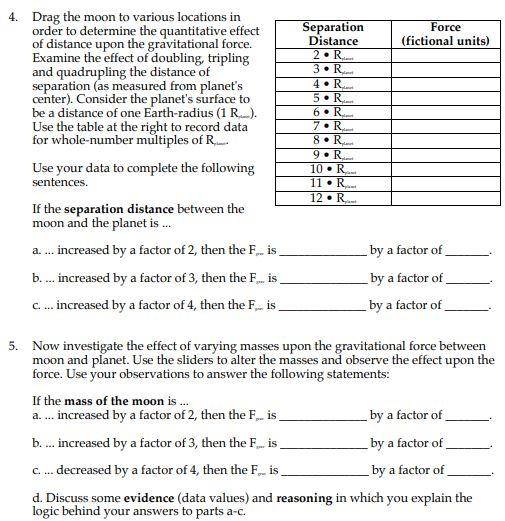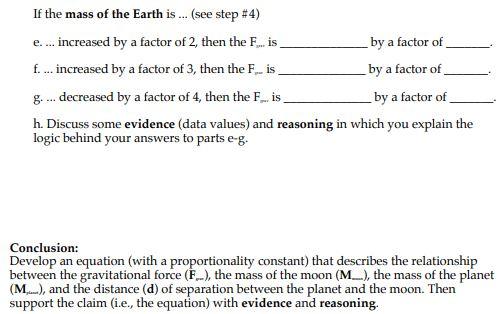Answered step by step
Verified Expert Solution
Question
1 Approved Answer
1. A planet and its moon are shown in the simulation window. Click and drag the moon to various positions about the planet and




1. A planet and its moon are shown in the simulation window. Click and drag the moon to various positions about the planet and observe the gravitational force vector. In the diagram below, draw a force vector (arrow with arrowhead) to depict the direction and relative magnitude of the force acting upon the moon at the designated locations. Note: the size of the arrow should be representative of the strength of the force. O O 0 2. Is the relationship between gravitational force and distance of separation (between moon and planet) an inverse or direct relationship? Explain the evidence for your conclusion. 3. Note that the simulation allows you to also display the force of the smaller moon pulling upon the larger planet. Click/tap the button to show the force acting upon the planet. Which force is largest: the force ON the smaller moon or the force ON the larger planet? Explain the evidence for your conclusion. 4. Drag the moon to various locations in order to determine the quantitative effect of distance upon the gravitational force. Examine the effect of doubling, tripling and quadrupling the distance of separation (as measured from planet's center). Consider the planet's surface to be a distance of one Earth-radius (1 R...). Use the table at the right to record data for whole-number multiples of R Use your data to complete the following sentences. If the separation distance between the moon and the planet is ... increased by a factor of 2, then the Fis b.... increased by a factor of 3, then the F... is c. ... increased by a factor of 4, then the F... is a.... If the mass of the moon is... a.... increased by a factor of 2, then the F... is Separation Distance 2. R 3. R 4. R 5. R 6. R 7. R 8. R 9. R 10. R... 11. R 12. R b. ... increased by a factor of 3, then the F... is c.... decreased by a factor of 4, then the F... is Force (fictional units) 5. Now investigate the effect of varying masses upon the gravitational force between moon and planet. Use the sliders to alter the masses and observe the effect upon the force. Use your observations to answer the following statements: by a factor of by a factor of by a factor of by a factor of by a factor of by a factor of d. Discuss some evidence (data values) and reasoning in which you explain the logic behind your answers to parts a-c. by a factor of If the mass of the Earth is... (see step #4) e.... increased by a factor of 2, then the F... is f. ... increased by a factor of 3, then the F... is g.... decreased by a factor of 4, then the F... is. by a factor of by a factor of h. Discuss some evidence (data values) and reasoning in which you explain the logic behind your answers to parts e-g. Conclusion: Develop an equation (with a proportionality constant) that describes the relationship between the gravitational force (F...), the mass of the moon (M), the mass of the planet (M.), and the distance (d) of separation between the planet and the moon. Then support the claim (i.e., the equation) with evidence and reasoning. Purpose: The purpose of this activity is to investigate the variables that affect the gravitational force between a planet and its moon.
Step by Step Solution
★★★★★
3.44 Rating (163 Votes )
There are 3 Steps involved in it
Step: 1
1 2 Is the relationship between gravitational force and distance of separation between moon and planet an inverse or direct relationship Answer Inverse Explanation The inverse square law is a principl...
Get Instant Access to Expert-Tailored Solutions
See step-by-step solutions with expert insights and AI powered tools for academic success
Step: 2

Step: 3

Ace Your Homework with AI
Get the answers you need in no time with our AI-driven, step-by-step assistance
Get Started


